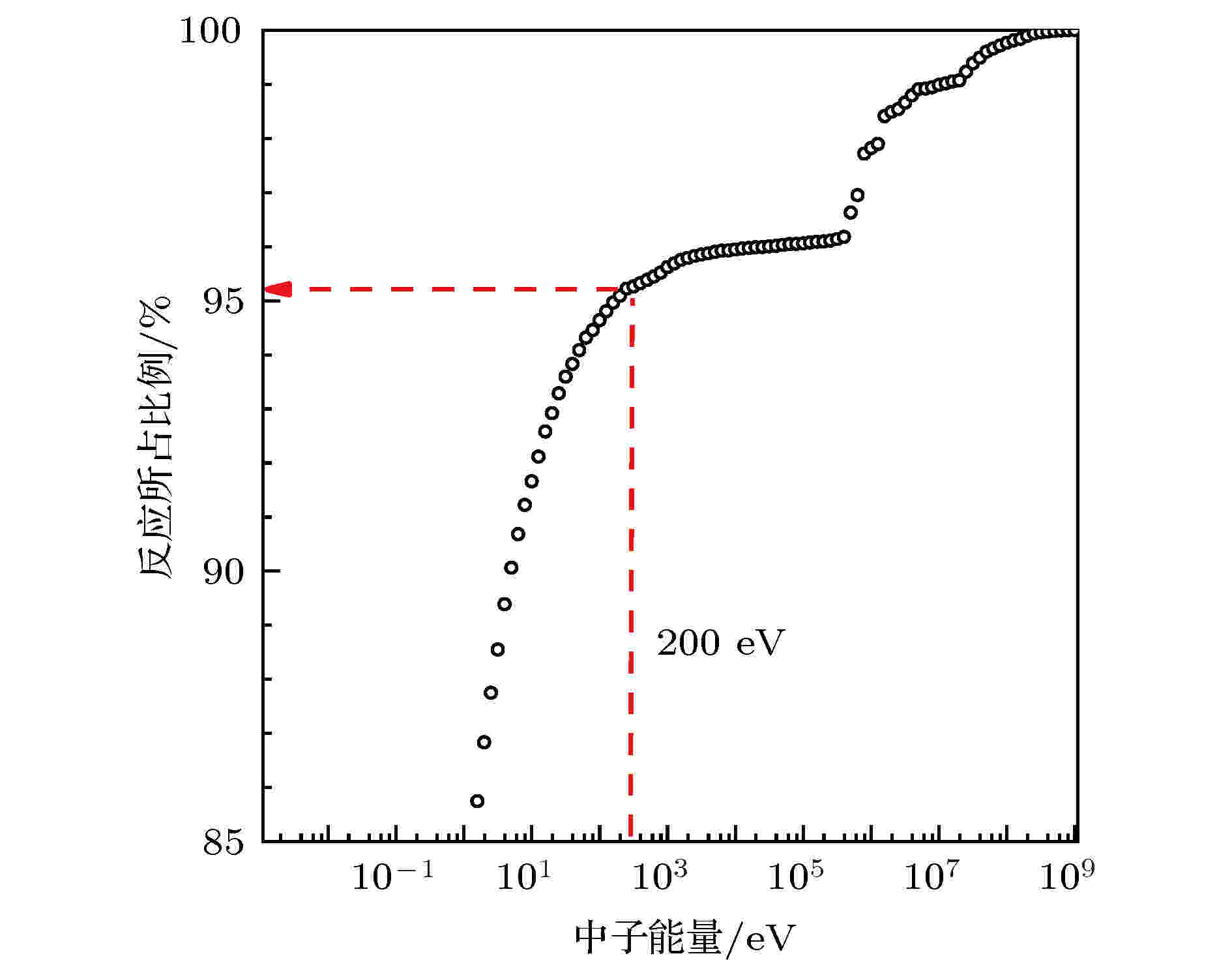全文HTML
--> --> -->近年来中子在GaN中的辐照损伤引起了很多科研工作者的兴趣. Kazukauskas等[7]研究了0.1 MeV中子对GaN单晶材料的辐照损伤, 中子注量为5.0 × 1014—1.0 × 1015 cm–2, 发现随着中子注量的增加, 热电流减小了几个数量级. 张明兰等[8]通过对中子辐照前后的GaN基器件持续光电导和低温光致发光的测量, 发现中子辐照会增强GaN的持续光电导率. 张得玺等[9]计算了中子在柵注入晶体管中p-AlGaN栅极、AlGaN沟道层和GaN外延层中的位移损伤情况, 结果显示随着中子注量的增加, 空位密度线性增大. 当中子注量为1014量级时, GaN沟道层空位密度为1016量级, 中子注量增加到1015量级时, 空位缺陷密度可达1017量级. 吕玲等[10]对AlGaN/GaN异质结进行平均中子能量1 MeV, 最高注量达1.0 × 1015 cm–2辐照后, 观察到面密度和迁移率降低, 电阻率明显增大的现象. Wang等[11-12]用中子辐照GaN外延层, 发现中子辐照导致载流子浓度减少, 并认为GaN外延层载流子浓度减少与中子辐照诱导结构缺陷产生载流子陷阱有关. 由国内外进展可知, 中子辐照下GaN材料中辐照诱生的结构缺陷会对GaN器件中载流子浓度、电导率以及电阻等参数造成一定的影响.
当宇宙射线进入大气层, 带有极高能量的粒子与大气中的原子核发生剧烈碰撞, 产生散裂反应, 由大气散裂反应产生的大气中子, 不带电且具有极强的穿透性, 广泛分布于地面和整个大气空间, 大气中子是导致GaN器件性能退化的主要粒子之一. 为了评价半导体器件在大气中子环境下长时间服役的可靠性, 可以借助反应堆的中子辐照环境进行辐照实验, 也可以通过计算模拟的方法模拟中子在材料中的辐照缺陷演化行为. 由于在不同的中子能谱辐照环境下, GaN中产生的位移损伤存在一定的差异, 有必要研究氮化镓在不同中子辐照环境下的位移损伤. 本文对不同中子辐照环境下氮化镓产生的初级反冲原子能谱和以离位原子数为权重的加权初级反冲原子谱进行了分析, 该工作对GaN基器件在大气中子环境以及不同裂变堆辐照环境下的辐照效应研究具有重要意义.
2.1.物理模型
Geant4能模拟多种粒子在具有复杂结构探测器中的输运过程, 定义入射粒子类型和能量分布, 追踪粒子输运过程和感兴趣的物理量, 添加自定义函数来实现额外的功能(如离位原子数的计算和不同中子能谱的读取), 已在核技术领域得到广泛应用[13-17].中子与物质相互作用主要包括弹性散射和一系列去弹过程(非弹性散射, 俘获效应和裂变反应). 弹性散射中, 靶材料原子被撞出晶格位置, 产生初级反冲原子[18]; 去弹过程会生成高能量反应产物, 这些高能产物会通过与原子核的屏蔽库仑散射在材料中慢化, 屏蔽库仑散射会传递足够高的能量使晶格原子离位, 导致位移损伤. 本文中材料经过中子辐照产生的初级反冲原子包含中子碰撞材料原子产生的初级反冲原子和去弹过程中产生的反应产物两个部分[19]. 中子与物质的相互作用采用高精度中子弹性散射、非弹性散射、俘获和裂变物理模型来模拟. 利用G4 hIonisation、G4 LElastic、G4 CascadeInterface模型模拟

2
2.2.入射中子能谱的选取
本文选取了四种典型的中子辐照环境(详见图1), 分别为大气中子谱[21]、压水堆能谱[22]、高温气冷堆[22]、高通量同位素堆外围辐照区域的能谱(简称同位素堆)[23]. 图 1 四种典型的归一化中子能谱
图 1 四种典型的归一化中子能谱Figure1. Four typical normalized neutron spectrum
2
2.3.几何结构
本文模拟的中子能谱范围主要在10–3—107 eV之间, 图2给出了不同能量的中子在氮化镓材料中的平均自由程, 为了确保统计的大多数中子与靶材料只发生一次相互作用, 靶材料厚度设为0.5 cm, 本文中Geant4建模的几何结构如图3所示, 大小为1 cm × 1 cm × 0.5 cm. 图 2 中子在GaN中的平均自由程
图 2 中子在GaN中的平均自由程Figure2. The mean free path of neutrons in GaN.
 图 3 Geant4中模拟的几何模型
图 3 Geant4中模拟的几何模型Figure3. Simulated geometric model in Geant4.
2
2.4.位移损伤计算
初级反冲原子产生的离位原子数Nd可通过NRT模型计算得出[24]:依据Akkerman[25]等研究, 当初级反冲原子能量低于200 keV时, (5)式修正为[12]
3.1.不同中子能谱辐照下产生的初级反冲原子份额
模拟的四种中子辐照环境下产生的初级反冲原子份额见表1. 从表1可知初级反冲原子中Ga、N占据主导, 但是伴随着核反应的发生, 也产生了C、B、H、He等元素, 其它元素包括Cu、Zn、Li等, 由于其份额过少, 这里没有一一列出. 通过表1可知, 不同中子能谱下, 核反应产生的元素存在微小的差别, 其中压水堆和高温气冷堆环境下, 核反应产物所占比例较为接近. 大气中子能谱环境下GaN中产生的C和H元素高于在压水堆和高温气冷堆环境下, 低于在同位素堆辐照环境下; 大气中子能谱环境下GaN中产生的B元素均低于其他三种中子辐照环境. 经估算, 当中子注量为1015量级时, 大气中子能谱下, GaN中由于核反应产生的C、B和H的浓度分别为6.33 × 10–13、1.62 × 10–14和6.38 × 10–13, 新生成的核反应产物有可能导致GaN基电子器件中半导体的能带结构发生改变, 进而影响其电学性能.| 能谱 | 初级反冲原子比例/% | ||||||
| Ga | N | C | B | H | He | other | |
| 大气中子 | 52.34 | 45.08 | 1.25 | 0.032 | 1.26 | 0.034 | 0.004 |
| 压水堆 | 54.26 | 43.39 | 0.92 | 0.25 | 0.92 | 0.25 | 0.01 |
| 高温气冷堆 | 54.87 | 43.62 | 0.52 | 0.23 | 0.52 | 0.23 | 0.01 |
| 同位素堆 | 48.27 | 44.94 | 3.28 | 0.11 | 3.28 | 0.11 | 0.01 |
表1不同能谱下初级反冲原子占比
Table1.Primary recoils proportion of different spectrum.
2
3.2.不同中子能谱辐照下的初级反冲原子能谱
从图4中可看出, 四种辐照环境下的初级反冲原子能谱总体上呈现一致的趋势, 且基本上随着反冲原子能量逐渐升高, 反冲原子所占比例越少, 即低能反冲原子占据优势. 大气中子辐照环境下初级反冲原子能量分布更广, 其他三种裂变堆能谱初级反冲原子能量范围基本一致, 由图1可知, 大气中子能谱能量分布范围比其他三种裂变堆能谱宽, 因此产生的初级反冲原子能谱更宽. 由图1中数据计算可知, 大气中子和同位素堆的平均中子能量分别为0.38 MeV和0.42 MeV, 压水堆和高温气冷堆的平均中子能量0.74 MeV 和0.76 MeV. 图4中大气中子和同位素堆下GaN的初级反冲原子能谱更为接近, 压水堆和高温气冷堆下GaN的初级反冲原子能谱更为接近, 这一现象可能和平均中子能量有关. 四种中子能谱的辐照环境下GaN中初级反冲原子能谱中, 均在0.58 MeV附近出现反冲原子能谱中不常见的固定位置的“尖峰”, 该尖峰的强度排序为: 同位素堆 > 大气中子 > 高温气冷堆 > 压水堆. 图 4 四种中子能谱在氮化镓中对应的初级反冲原子能谱
图 4 四种中子能谱在氮化镓中对应的初级反冲原子能谱Figure4. Primary recoil spectrum of four neutron spectra in GaN.
图5给出了同位素堆辐照环境下初级反冲原子能谱的解谱分析, 发现0.58 MeV 左右的尖峰主要由氢元素产生. 中子和GaN发生的产氢核反应主要是(9)式的反应过程, 图6给出了(9)式中核反应的

 图 5 高通量同位素堆外围辐照区环境下的初级反冲原子能谱分析
图 5 高通量同位素堆外围辐照区环境下的初级反冲原子能谱分析Figure5. Analysis of primary recoil spectrum over peripheral irradiation area in high flux isotope reactor.
 图 6 中子辐照氮化镓的
图 6 中子辐照氮化镓的
Figure6. (n,p)reaction cross section for GaN.
 图 7 产氢反应比例随中子能量变化
图 7 产氢反应比例随中子能量变化Figure7. Proportion of hydrogen production reaction varies with neutron energy.



 图 8 四种中子能谱的累积积分中子能谱
图 8 四种中子能谱的累积积分中子能谱Figure8. Cumulative integral neutron spectra of four neutron spectra.
图9给出了不同中子能谱在GaN中选取Ga、N、B、C四种初级反冲原子分别做初级反冲原子能谱. 由图9可知, 不同的初级反冲原子的初级反冲原子能谱也显示出大气中子能谱范围较宽; 几种主要的初级反冲原子能谱存在一定的差异, 其中压水堆能谱和高温气冷堆能谱下, GaN中的初级反冲能谱比较接近: 图9(d)中显示, 核反应产物C元素的初级反冲能谱中, 大气中子能谱和同位素堆能谱下比较接近.
 图 9 不同中子能谱在氮化镓中对应的初级反冲原子的能谱分布 (a)Ga初级反冲原子能谱; (b)N初级反冲原子的能谱; (c)B初级反冲原子的能谱; (d) C初级反冲原子的能谱
图 9 不同中子能谱在氮化镓中对应的初级反冲原子的能谱分布 (a)Ga初级反冲原子能谱; (b)N初级反冲原子的能谱; (c)B初级反冲原子的能谱; (d) C初级反冲原子的能谱Figure9. Primary recoils spectrum distribution for different neutron spectra for the primary recoil particle type of (a) Ga, (b) N, (c) B, (d) C.
2
3.3.加权初级反冲原子谱(Wp(T))
进一步将初级反冲原子能谱以反冲原子产生的离位原子数目作为权重, 进行累积积分, 得到加权初级反冲原子谱[28], 或损伤产生函数[29], 这里统一称为加权初级反冲原子谱(Wp(T)), 定义如下:


 图 10 四种中子能谱在氮化镓中对应的加权初级初级反冲原子谱Wp(T)
图 10 四种中子能谱在氮化镓中对应的加权初级初级反冲原子谱Wp(T)Figure10. Weighted primary recoil spectra of four neutron spectra in GaN.
由图10中可知, 大气中子能谱环境下比其余三种裂变堆能谱环境下, GaN中产生的初级反冲原子的能量分布整体处于较低的能量, 表明三种裂变谱下产生的反冲原子中较高能量初级反冲原子的份额高于大气中子能谱. 高温气冷堆和压水堆的加权初级反冲原子谱近似, 高通量同位素堆外围辐照区环境下, 高能初级反冲原子的份额比高温气冷堆和压水堆的低一些.
为了进一步对不同中子能谱产生的初态缺陷的形态分布进行分析, 分别考虑了中子在氮化镓中产生的不同类型的初级反冲原子(Ga、N、B、C). 它们对应的加权初级反冲原子谱如图11所示.
 图 11 所研究中子能谱在氮化镓中对应的加权初级反冲原子谱Wp(T) (a) Ga加权初级反冲原子谱; (b) N加权初级反冲原子谱; (c) B加权初级反冲原子谱; (d) C加权初级反冲原子谱
图 11 所研究中子能谱在氮化镓中对应的加权初级反冲原子谱Wp(T) (a) Ga加权初级反冲原子谱; (b) N加权初级反冲原子谱; (c) B加权初级反冲原子谱; (d) C加权初级反冲原子谱Figure11. Weighted primary recoil spectra of studied neutron spectra in GaN: (a) Ga; (b) N; (c) B; (d) C.
从图11整体来看, 对于Ga、N和B三种反冲原子, 三种裂变堆环境下的加权初级反冲原子谱基本一致. 图11(a)显示, 和其他三种压水堆能谱相比, 大气中子能谱下GaN中高能的Ga初级反冲原子和低能的Ga初级反冲原子所占份额都较大, 这是由于大气中子能谱较宽, 既产生更多的能量高的初级反冲原子, 也产生更多的能量低的初级反冲原子, 由于反冲原子的能量越大, 其产生离位级联损伤区越大, 因此大气中子辐照下, 有较大尺寸的离位损伤区产生. 图11(b)显示, 大气中子能谱下N初级反冲原子在低能区域占据更多份额, 图11(c)显示, 大气中子能谱下B初级反冲原子在高能区域占据更多份额. 图11(c)显示, 大气中子能谱和同位素堆能谱下C初级反冲原子的能量分布较为接近, 压水堆和高温气冷堆辐照下, C初级反冲原子在高能区域占据更多份额, 此外, 根据(9)式的产氢反应, 同时产生了大量相近能量的C初级反冲原子, 因此加权初级反冲原子谱图11(d)中观察到谱线急剧上升的现象.
GaN基器件经过中子辐照后, GaN材料中会生成许多具有一定能量的Ga、N、B和C等初级反冲原子, 这些带有一定能量的初级反冲原子会继续在GaN中通过离位级联进一步损失能量, 最后形成缺陷. 由于初级反冲原子的能量大小会影响到其在材料中的射程和形成缺陷的种类, 通过初级反冲原子能谱以及加权初级反冲原子的分析能够评价不同中子辐照环境下缺陷的形成变化. 由图4、图9—图11中四种中子能谱下GaN中的初级反冲能谱分布和加权初级反冲原子能谱分布可知, 大气中子能谱下GaN中初级反冲原子的能量分布较广, 大气中子和同位素堆下GaN的初级反冲原子能谱及加权初级反冲能谱更为接近. 对于GaN基器件的性能来说, 除了辐照缺陷能够影响材料的电学性能之外, 随着中子注量的增大, 核反应生成的B和C元素也越来越多, 有可能对半导体器件的能带结构造成一定影响, 结合表1中四种能谱下核反应产物的比例, 可知同位素堆更适于用于模拟大气中子能谱辐照实验.

